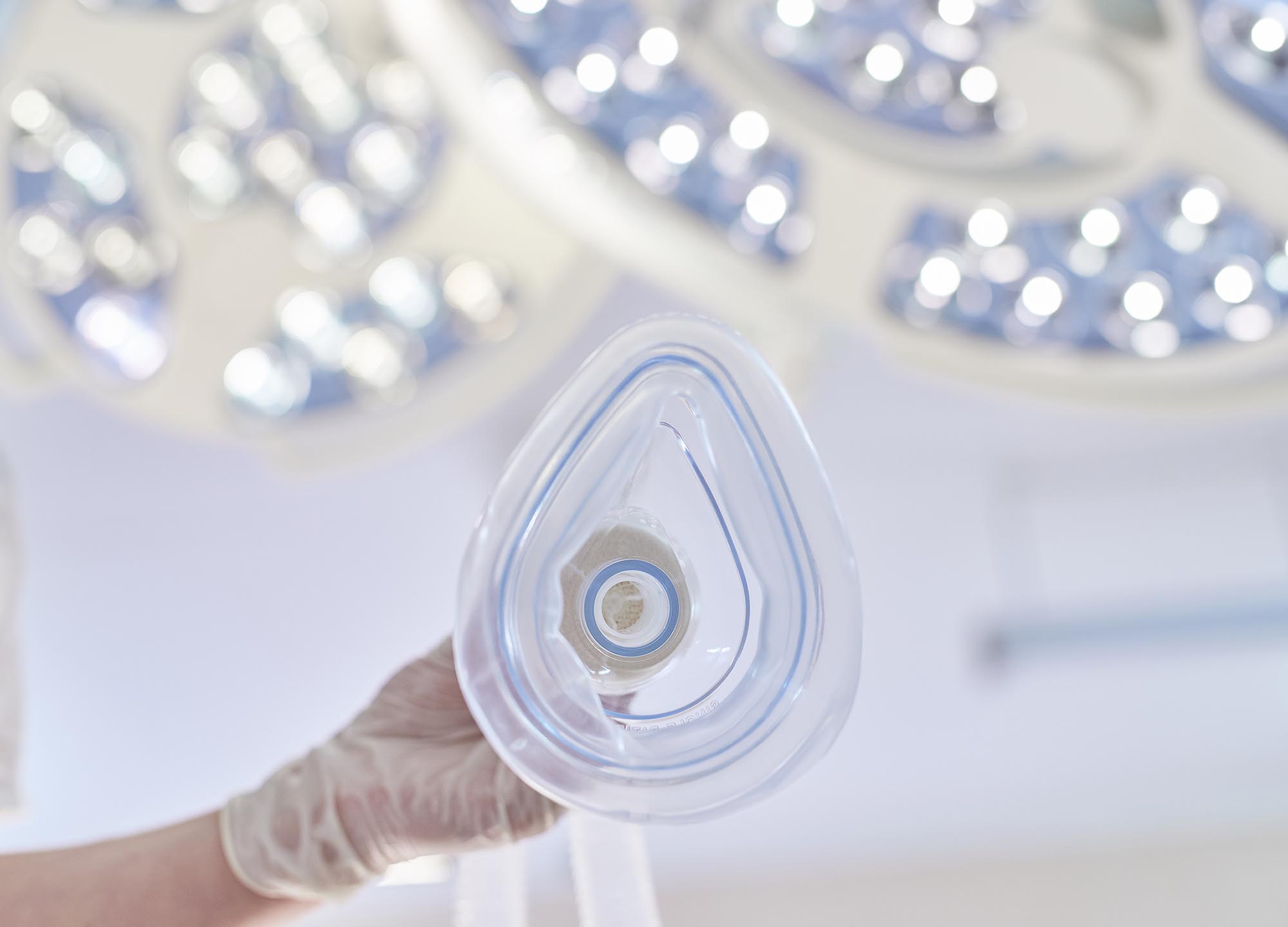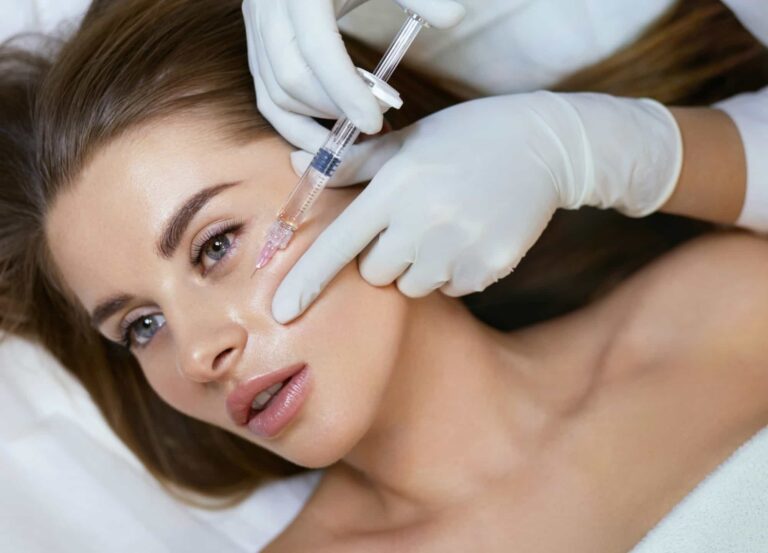Known for inducing fleeting bouts of euphoria, nitrous oxide (N2O), or laughing gas, boasts a storied history as a party drug—and according to a report in The New York Times, the inhalant has recently staged a pandemic-fueled comeback, despite numerous studies linking its chronic misuse to myriad neurological issues. In the medical field, of course, nitrous has long been prescribed, in controlled doses, to make everything from dental work to childbirth more bearable.
Over the past few years, nitrous oxide has seeped into the aesthetics realm, helping to take the edge off energy-based procedures and injectable treatments. When used in dermatology and plastic surgery, the gas is generally blended with oxygen and self-administered through a mouthpiece that requires patients to actively breathe in the mixture, via a system like Pro-Nox, which is found in thousands of practices across the country. (In cosmetic medicine, Pro-Nox has essentially become synonymous with laughing gas.)
As nitrous use grows in aesthetics, some doctors are raising concerns about the gas and the potential risks it poses—to both patients and the planet. Ahead, we take a closer look at the analgesic, its role in cosmetic medicine, and the questions surrounding its safety.
What is Pro-Nox, and how does it work?
Pro-Nox is a proprietary, patient-controlled system that delivers nitrous oxide and oxygen, in a fixed 50/50 ratio. According to Dr. Azza Halim, a board-certified anesthesiologist in Boca Raton, Florida, Pro-Nox targets the central nervous system, “acting on the GABA receptors and pain centers in the brain and spinal cord,” to ease discomfort and stress without altering consciousness. (In comparison, the nitrous oxide in dentists’ offices is typically a higher concentration, around 70%, “and can render sedation and loss of consciousness,” she says.) The effects of Pro-Nox are said to dissipate completely within five to seven minutes. (To be safe, providers usually have patients wait 10–15 minutes post-procedure before driving home.)
“Nitrous oxide is not truly metabolized, as some think,” adds Dr. Halim, noting that less than 0.004% is actually metabolized by humans. Rather, “it is exchanged through the lungs after diffusion and then exhaled, unchanged, into the atmosphere.”
Marcel Besse, the executive director for Pro-Nox’s aesthetics division, points out that “Pro-Nox is classified as an analgesic device and not anesthesia” by the U.S. Food and Drug Administration—an important distinction. “Traditionally, analgesia is pain relief without loss of consciousness and without total loss of feeling or movement,” explains Dr. Paul Goehner, a board-certified anesthesiologist in Palo Alto, California. “Anesthesia, on the other hand, [causes] the loss of physical sensation, with or without loss of consciousness.” Testifying to the benefits of nitrous oxide in general, he adds, “I’ve utilized nitrous for over 35 years and find it to be a very helpful adjunct.”
Unlike conventional nitrous oxide delivery systems, which release a steady stream of gas, Pro-Nox features what the company calls an “on-demand mouthpiece,” which lets patients regulate the amount of gas they consume. “The only time the N2O is flowing is when the patient has the mouthpiece securely in their mouth and is inhaling deeply,” Besse explains. This is thought to make the device safer, by obviating the risk of overdose while potentially improving the overall treatment experience. “Imagine you could control, by your breathing, the level of your sedation,” Dr. Goehner says. “The system requires the patient to interact to receive the gas. Once they’re comfortable, they can simply stop using it.”
While some providers charge for Pro-Nox—$50 to $100, depending on length of use—others offer it gratis, when they deem it to be a medically advisable part of treatment.
Common uses for Pro-Nox in cosmetic medicine
A 2021 survey of 204 dermatologists, plastic surgeons, and other aesthetics providers who use Pro-Nox in practice ranks the top 10 procedures performed with Pro-Nox. From most popular to least, the treatments include radiofrequency (RF) microneedling, ablative laser resurfacing, non-ablative laser resurfacing, ultrasound-based therapies, injectables, surgical procedures, PRP, RF skin tightening, facilitation of local or tumescent anesthesia, and standard microneedling. (The paper is currently pending publication.) Of the practitioners polled, 64.2% said they combine Pro-Nox with other pain-reducing medications. Rarely is Pro-Nox a stand-alone solution, notes Dr. Halim, “as the analgesic effect is very mild.”
The physicians we spoke to claim to reserve the inhalant as an add-on for procedures that truly demand it. “I believe that the anesthesia offered should be in proportion to the intensity of the treatment being performed,” says Dr. Jessica Weiser, a board-certified dermatologist in New York City. In her experience, “Pro-Nox is an excellent option for deep discomfort and pain that’s not responsive to topical anesthetic or other distraction techniques.” She uses it, primarily, for high-energy RF microneedling treatments and ultrasound-based skin tightening procedures, like Ultherapy and Sofwave, where numbing cream alone doesn’t do the trick. In such cases, “patients find that Pro-Nox allows them to relax and not feel anxiety or muscle tension that may result from uncomfortable procedures,” she says. It doesn’t erase the pain entirely but instead “enables patients to tolerate the procedures with relative ease,” she says.
The case for and against Pro-Nox for injectables
Whether Pro-Nox is suitable for routine shots, like Botox and fillers, is up for debate. Some physicians like to take advantage of the drug’s unique sedative properties when treating needle phobic patients. “Pro-Nox helps with anxiety, whereas topicals and nerve blocks do not,” notes Dr. Sara Moghaddam, a board-certified dermatologist in Selbyville, Delaware. So while she typically saves the gas for longer procedures, like laser resurfacing, “where the discomfort is ongoing and consistent for several minutes,” she will occasionally use it to help relax “very nervous filler patients” as well as those undergoing skin cancer surgery.
Seattle-based board-certified facial plastic surgeon Dr. Stella Desyatnikova admits to finding it “a little bit much” when folks request Pro-Nox for quick toxin or filler injections but says she has conceded a time or two, “when people need a lot of injections and have severe anxiety about pain and needles.” In one study, nitrous did significantly reduce the injection site pain associated with toxin injections for excessive sweating of the armpits and palms.
Dr. Halim doesn’t typically give it to injectable patients, because in her opinion, topical numbing is “more than sufficient” for shots—plus the disposable mouthpiece and tubing tend to interfere with precise facial injections, she says. Likewise, Dr. Weiser doesn’t offer Pro-Nox for injectable therapy, noting that “patients do not require this type of inhaled anesthesia for filler or neuromodulator treatment in my practice.”
Fearing that nitrous’s brain-blunting properties “could impair the patient’s ability to react to, express, or report excessive pain or other issues,” Dr. Hema Sundaram, a board-certified dermatologist in Fairfax, Virginia, and Rockville, Maryland, feels strongly that Pro-Nox should not be offered for injectable treatments (and has qualms about its use in general). “Numbing cream [which is customarily applied before injections] takes the edge off the pain, but it doesn’t dampen the patient’s ability to communicate with me if there is an inappropriately high pain level,” she says. “I don’t use nerve blocks [for filler] for the same reason—so as not to mask inappropriately high pain”—like that which could signal a vascular occlusion (filler blocking an artery and cutting off blood flow to the skin or retina).
Having used Pro-Nox in clinic for about three years, though, Dr. Moghaddam reports that “the best part about [it] is that the patient is still alert,” she says. “It seems to make most people feel more relaxed and zen”—but not so out of it that they won’t register a complication.
On a related note, Dr. Desyatnikova has found Pro-Nox to come in handy when treating vascular occlusions. (As a facial ultrasound expert, she frequently handles other injectors’ filler emergencies.) Having clots dissolved with high doses of the injectable enzyme hyaluronidase can be traumatic for people, she says, but Pro-Nox “makes it much easier to manage these patients, whose anxiety is through the roof because they’re thinking their face is going to fall off,” she says. Interestingly, she’s found that, in select cases, nitrous oxide can temporarily improve certain symptoms of vascular occlusion, like skin discoloration and blanching. While she’s currently investigating the exact mechanism in play, she theorizes that nitrous, by releasing nitric oxide in the tissues, may have a vasodilating effect that relieves spasming vessels near the blockage, allowing them to reperfuse affected skin. This is purely hypothetical, she emphasizes, and much more research needs to be done.
Pros, cons, and contraindications for nitrous oxide
The pros are pretty clear-cut: The physical and psychological effects kick in quickly and should be short-lived—the high vanishing moments after one’s final inhalation, “leaving patients feeling alert and able to carry on with their normal responsibilities immediately after treatment,” Dr. Weiser says. Additionally, patients appreciate being able to participate in the pain management process, our experts say. “Tolerances and perceptions of pain” vary widely, notes Dr. Goehner, so allowing the individual who is experiencing the discomfort to dictate the level of relief they need can be hugely beneficial. This rings especially true for angsty patients, since “feeling in control of the situation may help decrease their procedural anxiety,” notes Dr. Amanda Dilger, a board-certified facial plastic surgeon in Harwich, Massachusetts.
While most of our doctors say Pro-Nox is safe when used properly in appropriate patients, it’s not entirely risk-free. In the previously mentioned survey, 7.8% of providers saw side effects including headache, dizziness, nausea, and vomiting. In a separate study of nitrous in hair transplant patients, the most common adverse events were “mood lability”—everything from laughter to dissociation from one’s surroundings to crying—followed by nausea and dizziness.
Dr. Sundaram calls attention to case reports of seizures associated with nitrous oxide use, mainly in children. “I’m not saying it causes seizures in adult aesthetics patients,” she clarifies, “but it’s important to remember that every patient has a different threshold for side effects.”
Dr. Halim makes the point that sometimes issues arise, not so much from the gas itself but from the way people are inhaling it. “When someone hyperventilates, they’re blowing off too much carbon dioxide too fast, which causes dizziness and rapid heart rate, and then the added nitrous level building up too quickly results in undesirable side effects,” she says. “So when I see patients breathing in too much too fast, I have them stop or slow down.” Dr. Weiser adds that she too monitors patients’ intake throughout treatment and will “often suggest to them how many breaths are necessary and at what interval,” she says.
Some doctors argue that this sort of surveillance may distract from the treatment at hand. “There’s a significant risk [involved] when a provider who is untrained and unqualified in anesthesiology is administering—or having a patient self-administer—nitrous oxide while simultaneously trying to perform a procedure,” cautions Dr. Sundaram. “Optimal performance of any aesthetic procedure requires razor-sharp focus.”
Finally, not everyone is a candidate for Pro-Nox. Contraindications—which should be outlined, along with risks, in the informed consent forms your provider has you sign prior to treatment—include but aren’t limited to pregnancy, vitamin B12 deficiency, middle ear occlusion, ear infections, recent eye surgery with intraocular gas injection, decompression sickness, and certain intra-abdominal and intestinal conditions. “Informed consent to a procedure also includes knowing what emergency measures are in place if something goes wrong—even if the risk is small,” adds Dr. Sundaram. She suggests asking, for example, if providers have crash carts in their offices or certification in basic resuscitation, should something go awry.
Who’s legally allowed to offer Pro-Nox?
“Anyone who can write a prescription for pain medication, according to the state [in which] they are licensed, can purchase and offer Pro-Nox,” says Besse. In most states, he adds, doctors, nurse practitioners, and physician associates are allowed to do so. Since Pro-Nox is, technically, an analgesic device, no formal anesthesiology experience is required to supply the drug. While the company says it offers training to anyone who buys the system, some physicians feel that’s not enough.
“When I bought [the device], there was very little training for me,” says Dr. Desyatnikova. “I think that’s something that should actually be improved,” she notes, since providers of various backgrounds and qualifications are supervising its use. Dr. Sundaram is uncomfortable with the overall lack of training for Pro-Nox as well as the nebulous guidelines pertaining to “patient assessment prior to administering Pro-Nox, including how to screen for patients in whom it may be contraindicated or those in whom it should be used with caution, due to their medical history,” she says. What if a patient is unaware that she’s in her first trimester of pregnancy, for instance?
The environmental impact of nitrous oxide
Inhaled anesthetics, in general, are greenhouse gases. Scientists have been investigating their collective global warming potential (GWP)—and that of nitrous oxide, specifically—since the 1980s. In a 2011 review of the topic, researchers call out nitrous for its “long atmospheric lifetime”—it hangs around for more than a century. A 2019 paper references an earlier work calculating the GWP of nitrous oxide over 100 years to be 298 times that of carbon dioxide. And a 2020 study reveals that “nitrous oxide is responsible for the majority of ongoing ozone depletion”—and urges anesthesiologists to avoid it, as a means of reducing their carbon loads.
“We should all be concerned about our individual and collective greenhouse gas emissions,” says Dr. Brian Chesebro, a board-certified anesthesiologist in Portland, Oregon, and the medical director of environmental stewardship for Providence Portland Medical Center. “Since nitrous oxide not only is a potent greenhouse gas but also depletes the ozone layer, extremely judicious clinical use is in order.” He goes on to explain that when it’s used routinely in the OR, over the course of a year, one individual anesthesiologist has a nitrous-oxide footprint that’s roughly equivalent to burning eight to nine tons of coal. “We should really weigh these large-emission impacts against the clinical benefit and provide this information to our patients as part of an informed consent,” he says.
As a member of Climate Code Blue, a Boston-based physician activist group focused on climate change, Dr. Dilger worries about the increasing use of nitrous by aesthetic practitioners in an outpatient setting. “Even if it’s being used intermittently [as is the case with Pro-Nox], it still ends up being measurable,” she maintains.
While laughing gas’s precise planetary toll is somewhat murky, eco-conscious patients may want to consider greener alternatives or reserve it for major cosmetic procedures. “Clinicians and patients should be aware of the environmental impacts of nitrous oxide and carefully weigh these against potential advantages,” adds Dr. Chesebro. “The use of nitrous oxide requires a clear clinical indication for a specific patient—it should not be the default practice.”











